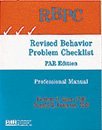
Revised Behavior Problem Checklist - PAR Edition rbpc
For: Rate problem behaviours in children and adolescents ages 5-18 years
Reading Level: Child - Adolescent
Format: Paper-and-Pencil
Length: 20 minutes to administer; 10 minutes to score and profile
Scoring: Hand Scored
Printed Forms & Handscoring Materials
Test forms, response booklets and scoring reference manuals.
RBPC-PAR Edition Profile Sheets (25)
RBPC-PAR Edition Test Booklets (25)
Authors
Herbert C. Quay, PhD, Donald R. Peterson, PhD
Description
The RBPC is used to rate problem behaviours observed in adolescents and young children ages 5-18 years. The six RBPC subscales measure Conduct Disorder, Socialised Aggression, Attention Problems-Immaturity, Anxiety-Withdrawal, Psychotic Behaviour and Motor Tension-Excess.
The RBPC has been used for a wide variety of purposes:
To screen for behavioural disorders in schools
As an aid in clinical diagnosis
To measure behavioural change associated with psychological or pharmacological interventions
As part of a battery to classify juvenile offenders
To select subjects for research on behavioural disorders in children and adolescents
Overview of the RBPC Scales
Conduct Disorder (CD/22) -Items focus on behavioural problems of physical aggression, difficulty controlling anger, and open disobedience, defiance, and oppositionality.
Socialised Aggression (SA/17) -Items tap behaviours associated with Adolescent Conduct Disorder. Items focus on the commission of conduct-disordered behaviours in the company of others, including stealing and substance use in the company of others, truancy from school, gang membership, stealing, and lying.
Attention Problems-Immaturity (AP/16) -Items focus on symptoms associated with Attention Deficit Disorder (ADD), including short attention span, diminished concentration, distractibility, impulsivity, as well as the social and interpersonal correlates of ADD, including passivity, undependability, and childishness.
Anxiety-Withdrawal (AW/11) -Items measure the behavioural components of internalising disorders, including poor self-confidence and self-esteem, hypersensitivity to criticism and rejection, generalised fearfulness and anxiety, and reluctance to try new behaviours because of fear of failure.
Psychotic Behaviour (PB/6) -Items tap psychotic symptoms, including speech disturbance, bizarre ideation, delusions, and impaired reality testing.
Motor Tension-Excess (ME/5) -Items focus on motoric symptoms of overactivity, including restlessness, tension, and “jumpiness.”
Administration and Scoring
Administration and scoring are straightforward. Raters respond to the 89 items on the top page of the carbonless Test Booklet. Responses transfer to the bottom sheet, which contains scoring instructions and a scoring key. The RBPC Profile Sheet is used to record the obtained raw and T scores and to plot the pattern of the test results.
The Professional Manual contains information on the development of the RBPC, psychometric properties, additional reliability and validity studies, and tables for converting raw scores to T scores. Norms based on teacher ratings are provided for Grades K-12. Mean internal consistency reliabilities range from .73-.94 for the six subscales. Interrater reliabilities, based on teacher ratings, range from .52-.85.
The Rating Form is designed for use in conjunction with other measures (e.g. intelligence and achievement tests, behaviour observations, and interviews) as part of an overall assessment of the individual. The Rating Form may be completed by a parent, teacher, or other observer in about 20 minutes. Scoring and profiling take about 10 minutes.
NB: Prices are in Australian dollars inclusive of GST. NZ customers need to log in to view ex-GST prices.



